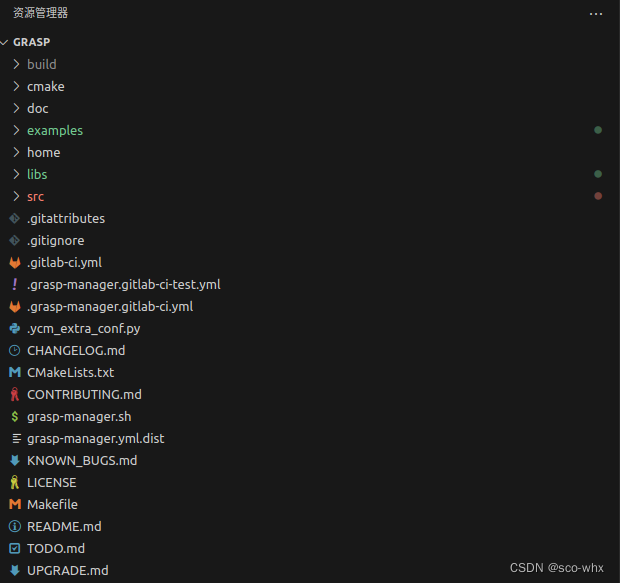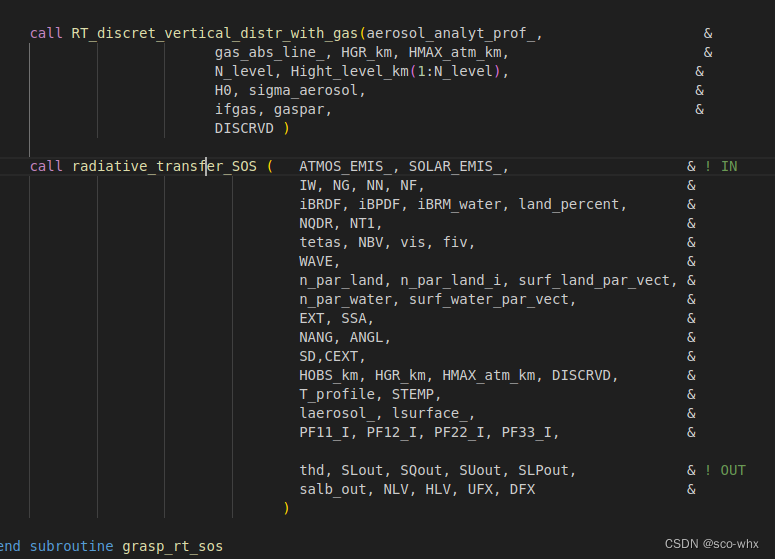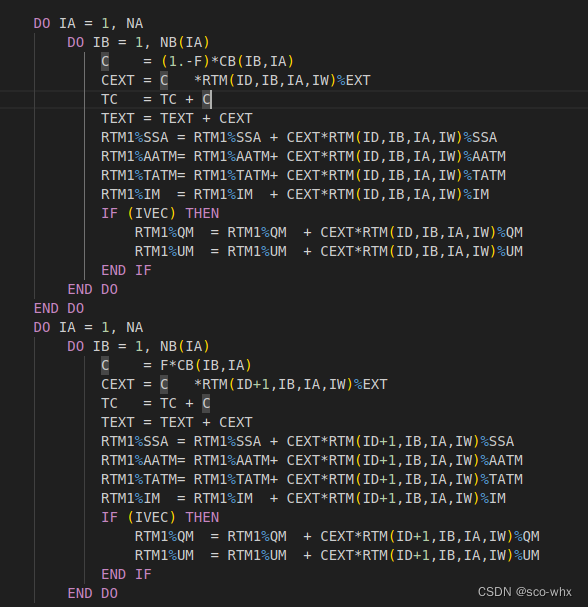
上图为GRASP软件包中包含的文件,其中关键的算法部分包含在src文件夹中。
下方链接是GRASP官方提供的文件目录。
http://www.grasp-open.com/tech-doc/dir_68267d1309a1af8e8297ef4c3efbcdba.php![]() http://www.grasp-open.com/tech-doc/dir_68267d1309a1af8e8297ef4c3efbcdba.php一、forward_model 结构整理
http://www.grasp-open.com/tech-doc/dir_68267d1309a1af8e8297ef4c3efbcdba.php一、forward_model 结构整理

1.1 .1example_fw.c

radiative_transfer_args 是 external_interface.h 中定义的结构体 ,external_interface.h 代码如下: radiative_transfer_args_ 定义了辐射传输的输入参数;radiative_transfer_result_ 定义了输出结果参数;grasp_rt_sos函数定义了辐射传输所需的所有参数(输入+输出)。
#include <stdbool.h>
#include "mod_par_OS.inc"
#include "mod_par_DLS.inc"
#include "mod_par_inv.inc"
#ifndef EXTERNAL_INTERFACE_H
#define EXTERNAL_INTERFACE_H
#define MAX(x,y) ((x>y)?x:y)
#define _NLEVEL_GAS _KVERT_WD
typedef struct radiative_transfer_args_ {
int IW; /**< @brief IW: Index of the position of the wavelength */
int NG; /**< @brief NG - Number of gaussian quadrature points */
int NN; /**< @brief NN - Number of quadrature expansions */
int NF; /**< @brief NF - Maximum number of Fourier terms */
int iBRDF; /**< @brief iBRDF - Establish if surface directional scattering is taken into account */
int iBPDF; /**< @brief iBPDF - Establish if surface polarization is taken into */
int iBRM_water; /**< @brief iBRM_water - Type of water surface model */
float land_percent; /**< @brief land_percent - Percent of surface corresponding to land model */
int NQDR; /**< @brief NQDR - Number of angular quadrature points */
int NT1[2]; /**< @brief NT1 - Number of layers */
float tetas; /**< @brief tetas - Solar Zenith Angle */
int NBV; /**< @brief NBV - Number of observations */
float vis[2 * _NBVM]; /**< @brief vis - Observation Zenith angle (degrees) */
float fiv[2 * _NBVM]; /**< @brief fiv - Observation Azimuth angle (degrees) */
float WAVE; /**< @brief WAVE - Wavelength in micrometers */
int n_par_land; /**< @brief n_par_land - total number of surface parameters (BRDF+BPDF) for land */
int n_par_land_i; /**< @brief n_par_land_i - number of BRDF surface parameters for land */
float surf_land_par_vect[2 * _KBF]; /**< @brief surf_land_par_vect - Parameters describing land surface */
int n_par_water; /**< @brief n_par_water - number of BRDF surface parameters for water */
float surf_water_par_vect[_KBF]; /**< @brief surf_water_par_vect - Parameters describing water surface */
float EXT[_NMM + _NMG]; /**< @brief EXT - Extinction for each */
float SSA[_NMM + _NMG]; /**< @brief SSA - Single scattering albedo for each atmospheric component */
int NANG; /**< @brief NANG - number of scattering angles of phase matrix NANG */
float ANGL[_KMpar]; /**< @brief ANGL - Scattering angles in which is defined PF11_I */
float SD[_KIDIM3][_KSD]; /**< @brief SD - RT kernels approach: Size distribution. Related to LUT generation */
float CEXT[_KSD]; /**< @brief CEXT - RT kernels approach: extinction. Related to LUT generation */
float HOBS_km; /**< @brief HOBS_km - Height of observation in km */
float HGR_km; /**< @brief HGR_km - Station altitude in km */
float HMAX_atm_km; /**< @brief HMAX_atm_km - Atmosphere maximum altitude */
int NHVP_retr; /**< @brief NHVP_retr - Number of altitudes for retrieved vertical profile */
float HVP_retr_km[_KVERTM]; /**< @brief HVP_retr_km - Altitudes for retrieved vertical profile */
float H0[_KVERTM][_KSD]; /**< @brief H0 - Contains parameters of aerosol vertical distribution or distribution itself */
float sigma_aerosol[_KSD]; /**< @brief sigma_aerosol - Parameters for aerosol vertical profile shape */
int ifgas; /**< @brief ifgas - Selects if gas absorption is incuded or not (old gas model) */
float gaspar; /**< @brief gaspar - Gas absorption value (old gas model) */
float T_profile[_NLEVEL_GAS]; /**< @brief T_profile - Temperature profile for each level Only necessary if emission is accounted */
float STEMP; /**< @brief STEMP - Surface temperature. Only necesary if emission is accounted */
bool laerosol; /**< @brief laerosol - Selects if aerosol is present in the atmosphere */
bool lsurface; /**< @brief lsurface - Selects if surface is present in the calculations */
bool ATMOS_EMIS; /**< @brief ATMOS_EMIS - To account for thermal emission */
bool SOLAR_EMIS; /**< @brief SOLAR_EMIS - If emission is accounted it is used to account for solar contribution */
float PF11_I[_KMpar][_KSD]; /**< @brief PF11_I - Aerosol phase matrix */
float PF12_I[_KMpar][_KSD]; /**< @brief PF12_I - Aerosol phase matrix */
float PF22_I[_KMpar][_KSD]; /**< @brief PF22_I - Aerosol phase matrix */
float PF33_I[_KMpar][_KSD]; /**< @brief PF33_I - Aerosol phase matrix */
int NLV; /**< @brief NLV - Number of levels */
float HLV[_KNT]; /**< @brief HLV - Height of levels */
int aerosol_analyt_prof; /**< @brief aerosol_analyt_prof - Marks if the the exact aerosol profiles is known or an analytic shape is going to be taken */
int gas_abs_line; /**< @brief gas_abs_line - Marks if there is gas absorption included (new model) */
int N_level; /**< @brief N_level - Number of levels */
float Hight_level_km[MAX(_KVERTM, _KVERT_WD)]; /**< @brief Hight_level_km - Aerosol profile height */
int nh; /**< @brief nh - Number of layers in the aerosol profile */
float h_km[_KVERT_WD]; /**< @brief h_km - Height of layers in the aerosol profile */
int natm; /**< @brief natm - Number of total atmospheric components */
int naer; /**< @brief naer - Number of total aerosol modes */
int nmol; /**< @brief nmol - Number of total molecular components */
int ngas; /**< @brief ngas - Number of total gaseous components */
float norm_DISCRVD[_NMM + _NMG]; /**< @brief norm_DISCRVD - Norm of atmospheric vertical profile */
bool ISGL; /**< @brief ISGL - To restrict the code to single scattering calculations */
bool IAER; /**< @brief IAER - Selects if aerosol must be considered */
bool IVEC_CTL; /**< @brief IVEC_CTL - To restrict the calculation to scalar equations */
bool ISRF; /**< @brief ISRF - Selects if surface must be accounted */
bool IDWN; /**< @brief IDWN - Marks if the calculations are upwards or downwards */
bool IFLX; /**< @brief IFLX - Marks is flux calculations is going to be done (not possible with the actual approach of the stand alone RT) */
bool IGQ_F; /**< @brief IGQ_F - Quadrature calculation in forward mode */
bool IGQ_D; /**< @brief IGQ_D - Quadrature calculation for dericatives in inversion mode */
bool IGQ_BRM_FEXP; /**< @brief IGQ_BRM_FEXP - Surface quadrature calculations for Fourier components */
bool IGQ_BRM_HSPH; /**< @brief IGQ_BRM_HSPH - High precision surface quadrature calculations */
bool IP_VERBOSE; /**< @brief IP_VERBOSE - Related with output format */
bool IP_ADDITION; /**< @brief IP_ADDITION - Related with output additional information */
bool ITRC; /**< @brief ITRC - Marks if Phase matrix truncation is going to be done */
bool ISCA; /**< @brief ISCA - Output in scattering or meridian plane */
bool IVEC_SET; /**< @brief IVEC_SET - Scalar or vector calculations */
bool IWUT; /**< @brief IWUT - Lut generation */
bool ILUT; /**< @brief ILUT - Use LUTs already generated */
bool IATM; /**< @brief IATM - Choose between bihemispherical or directional hemispherical reflectance of atmosphere */
bool ICRR; /**< @brief ICRR - Atmospheric correction */
bool boa_ref; /**< @brief boa_ref - Selectes between different surface models */
int AER_PRF; /**< @brief AER_PRF - Aerosol profile shape */
int MOL_PRF; /**< @brief MOL_PRF - Molecular profile shape */
int NA; /**< @brief NA - RT kernels approach: number of aerosol modes */
int NB[_KSD]; /**< @brief NB - RT kernels appraoch: number of aerosol */
int NLYR[2]; /**< @brief NLYR - Number of layers */
float EPS; /**< @brief EPS - Related with precision of some numerical expansions */
} radiative_transfer_args;
typedef struct radiative_transfer_result_ {
float thd[2*_NBVM]; /**< @brief thd - Measurement azimuth angle (degrees) */
float SLout[2*_NBVM]; /**< @brief SLout - Calculated radiance in the selected viewing geometry */
float SQout[2*_NBVM]; /**< @brief SQout - Calculated radiance in the selected viewing geometry */
float SUout[2*_NBVM]; /**< @brief SUout - Calculated radiance in the selected viewing geometry*/
float SLPout[2*_NBVM]; /**< @brief SLPout - Calculated radiance in the selected viewing geometry */
float salb_out; /**< @brief salb_out - Surface albedo */
float UFX[_KNT]; /**< @brief UFX - Fluxes */
float DFX[_KNT]; /**< @brief DFX - Fluxes */
} radiative_transfer_result;
/*
* Actual function is implemented in fortran, which is why we have the full list of parameters here as well
*/
extern void grasp_rt_sos_(int IW, int NG, int NN, int NF,
int iBRDF, int iBPDF, int iBRM_water, float land_percent,
int NQDR, int NT1[2], float tetas, int NBV, float vis[2*_NBVM], float fiv[2*_NBVM],
float WAVE,
int n_par_land, int n_par_land_i, float surf_land_par_vect[2*_KBF],
int n_par_water, float surf_water_par_vect[_KBF],
float EXT[_NMM+_NMG], float SSA[_NMM+_NMG],
int NANG, float ANGL[_KMpar],
float SD[_KIDIM3][_KSD], float CEXT[_KSD],
float HOBS_km, float HGR_km, float HMAX_atm_km,
int NHVP_retr, float HVP_retr_km[_KVERTM],
float H0[_KVERTM][_KSD], float sigma_aerosol[_KSD],
int ifgas, float gaspar,
float T_profile[_NLEVEL_GAS], float STEMP,
bool laerosol, bool lsurface,
bool ATMOS_EMIS, bool SOLAR_EMIS,
float PF11_I[_KMpar][_KSD], float PF12_I[_KMpar][_KSD],
float PF22_I[_KMpar][_KSD], float PF33_I[_KMpar][_KSD],
int NLV, float HLV[_KNT],
int aerosol_analyt_prof, int gas_abs_line,
int N_level,
float Hight_level_km[MAX(_KVERTM,_KVERT_WD)],
int nh,
float h_km[_KVERT_WD],
int natm, int naer, int nmol, int ngas,
float norm_DISCRVD[_NMM+_NMG],
bool ISGL, bool IAER, bool IVEC_CTL, bool ISRF, bool IDWN, bool IFLX,
bool IGQ_F, bool IGQ_D, bool IGQ_BRM_FEXP, bool IGQ_BRM_HSPH,
bool IP_VERBOSE, bool IP_ADDITION, bool ITRC, bool ISCA, bool IVEC_SET,
bool IWUT, bool ILUT, bool IATM, bool ICRR, bool boa_ref,
int AER_PRF, int MOL_PRF,
int NA, int NB[_KSD],
int NLYR[2], float EPS,
float thd[2*_NBVM],
float SLout[2*_NBVM], float SQout[2*_NBVM], float SUout[2*_NBVM], float SLPout[2*_NBVM],
float *salb_out,
float UFX[_KNT], float DFX[_KNT]);
void grasp_rt_sos(radiative_transfer_args *args, radiative_transfer_result *result);
#endif //EXTERNAL_INTERFACE_H所以,example_fw.c 对辐射传输进行了初始化赋值。(并无计算过程,example)
1.1.2 example_fw.f90
初始化辐射传输的相关参数,并调用了(call)external_interface.f90文件中的grasp_rt_sos子程序。

在grasp_rt_sos子程序中,又调用了下面两个子程序,分别是有关气体垂直分布、辐射传输的子程序。(后续详细介绍)
1.2 radiative_transfer/rt_sos

1.2.1 mod_par_os.f90
定义一些参数并赋值

1.2.2 mod_rt_sos_lut.f90
有关辐射传输过程中的LUT操作
二分查找AOD1在查找表中的位置:

进而计算出辐射传输中的相关参数

1.2.3 mod_rt_sos_ms.f90
有关辐射传输中多次散射的计算,具体内容可参考源代码中的注释。1
1.2.4 mod_rt_sos_setup.f90
"
DESCRIPTION:
!> setup and control flags in radiative transfer
"
1.2.5 mod_rt_sos.f90

| SUBROUTINE radiative_transfer_SOS | |
| subroutine surface1 | |
| subroutine aerosol1 | |
| SUBROUTINE phase_matrix_intrpl_NQDR | |
| SUBROUTINE MODIF_DE_TRONC | |
| subroutine gauss | |
| subroutine developpe_ocean_land | |
| subroutine betal | |
| subroutine legendre | |
| subroutine root | |
| subroutine profiles_WD | |
| subroutine get_WD | |
1.2.6 mod_rt.f90





















 1万+
1万+











 被折叠的 条评论
为什么被折叠?
被折叠的 条评论
为什么被折叠?








